List of extant papal tombs
This article is missing information about the dates some of the monuments were created which, in some cases, is long after the pope's death. (March 2020) |
This article relies largely or entirely on a single source. (March 2020) |

A pope is the Bishop of Rome and the leader of the Catholic Church. Approximately 100 papal tombs are at least partially extant, representing less than half of the 264 deceased popes, from Saint Peter to Saint John Paul II.[1]
For the first few centuries in particular, little is known of the popes and their tombs, and available information is often contradictory. As with other religious relics, multiple sites claim to house the same tomb. Furthermore, many papal tombs that recycled sarcophagi and other materials from earlier tombs were later recycled for their valuable materials or combined with other monuments. For example, the tomb of Pope Leo I was combined with Leos II, III, and IV circa 855, and then removed in the seventeenth century and placed under his own altar, below Alessandro Algardi's relief, Fuga d'Attila. The style of papal tombs has evolved considerably throughout history, tracking trends in the development of church monuments.[2] Notable papal tombs have been commissioned from sculptors such as Michelangelo and Gian Lorenzo Bernini.
Most extant papal tombs are located in St. Peter's Basilica, other major churches of Rome (especially Archbasilica of Saint John Lateran, Santa Maria sopra Minerva and Basilica di Santa Maria Maggiore), or other churches of Italy, France, and Germany.[3]
| Papal tombs by century of the pontificate |
|---|
| Non-extant · Antipopes |
Note on non-extant tombs[]
Many early tombs no longer exist due to repeated translations or destruction. This list does not include non-extant papal tombs. Information about these tombs is generally incomplete and uncertain. Locations of destroyed or lost papal tombs include:
- Saint Peter's tomb, around which the following popes were traditionally believed to have been buried: Pope Linus, Pope Anacletus, Pope Evaristus, Pope Telesphorus, Pope Hyginus, Pope Pius I, Pope Anicetus (later transferred to the Catacomb of Callixtus), and Pope Victor I.[4] Epigraphic evidence exists only for Linus, with the discovery of a burial slab marked "Linus" in 1615; however, the slab is broken such that it could have once read "Aquilinius" or "Anullinus".[5]
- The Catacombs of Rome, specifically the Catacomb of Callixtus, the Catacomb of Priscilla (beneath San Martino ai Monti), the Catacomb of Balbina, the Catacomb of Calepodius, the Catacomb of Pontian, and the Catacomb of Felicitas, which were emptied by repeated translations by the ninth century.[6]
- Papal tombs in Old St. Peter's Basilica, which once numbered over 100 papal tombs, nearly all of which were destroyed during the sixteenth/seventeenth century demolition.[7]
- Archbasilica of Saint John Lateran, where over a dozen tombs were destroyed in two fires (1308 and 1361).[8]
Other tombs not included in this list are:
- Tombs of antipopes, which—with few exceptions—are obscure or destroyed. An antipope is a historical papal claimant currently regarded by the Roman Catholic Church as illegitimate. Notably, however, the Tomb of Antipope John XXIII is in the Battistero di San Giovanni in Florence.
- Santi Vincenzo e Anastasio a Trevi, the resting place of the precordium of 22 popes from Sixtus V (1585–1590) to Leo XIII (1878–1903).
1st–5th centuries[]
1st century[]
| Pontificate | Portrait | Common English name | Image | Sculptor | Location | Notes |
|---|---|---|---|---|---|---|
| 30–67 (as Head of the Church) |

|
Peter Saint Peter |
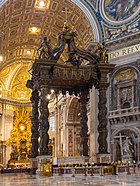 
|
Gian Lorenzo Bernini (baldachin) | St. Peter's Basilica, Vatican City (Rome) | See Saint Peter's tomb |
| post 42 / ante 57–64/67(?) (as Bishop of Rome) |
2nd century[]
| Pontificate | Portrait | Common English name | Image | Sculptor | Location | Notes |
|---|---|---|---|---|---|---|
| c. 157–168 | 
|
Anicetus Saint Anicetus |
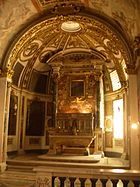
|
Palazzo Altemps (Piazza Navona), Rome | Remains transferred from Vatican Hill to the Cemetery of Callixtus and possibly again thereafter;[9] sarcophagus which may once have contained remains is extant in the Palazzo Altemps[10] |
3rd century[]
| Pontificate | Portrait | Common English name | Image | Sculptor | Location | Notes |
|---|---|---|---|---|---|---|
| 25 June 253 – 5 March 254 | 
|
Lucius I Saint Lucius |

|
Santa Cecilia in Trastevere, Rome | Transferred from the Catacomb of Callixtus to one or more of: Santa Cecilia in Trastevere, San Silvestro in Capite, and Santa Prassede;[11] sarcophagus that once held remains is extant in the crypt of Santa Cecilia in Trastevere[10] | |
| 17 December 283 – 22 April 296 | 
|
Caius Saint Caius |

|
Sant'Andrea della Valle (Barberini chapel), Rome | Translated from the crypt of St. Eusebius in the Cemetery of Callixtus to San Silvestre in Capite, then to another church, then to the private chapel of the Barberini princes in Sant'Andrea della Valle[12] |
4th century[]
| Pontificate | Portrait | Common English name | Image | Sculptor | Location | Notes |
|---|---|---|---|---|---|---|
| 18 January 336 – 7 October 336 | 
|
Mark Saint Mark |

|
San Marco Evangelista al Campidoglio, Rome | Translated from the Catacomb of Balbina, one of the Catacombs of Rome, to an urn below the main altar of San Marco[13] |
5th century[]
| Pontificate | Portrait | Common English name | Image | Sculptor | Location | Notes |
|---|---|---|---|---|---|---|
| 29 September 440 – 10 November 461 | 
|
Leo I Saint Leo Leo the Great |

|
Alessandro Algardi (relief) | St. Peter's Basilica, Chapel of the Madonna of Partorienti | First pope buried on the porch of Old St. Peter's Basilica; translated multiple times, combined with Leos II, III, and IV circa 855; removed in the seventeenth century and placed under his own altar, below Algardi's relief, Fuga d'Attila (pictured)[14] |
6th–10th centuries[]
6th century[]
| Pontificate | Portrait | Common English name | Image | Sculptor | Location | Notes |
|---|---|---|---|---|---|---|
| 3 September 590 – 12 March 604 | 
|
Gregory I, O.S.B. Saint Gregory Gregory the Great |

|
Unknown | St. Peter's Basilica | Originally buried in the portico of Old St. Peter's, partly transferred to Soissons; during the demolition of St. Peter's, transferred to Sant'Andrea della Valle then , near the entrance of the modern St. Peter's[15] |
7th century[]
| Pontificate | Portrait | Common English name | Image | Sculptor | Location | Notes |
|---|---|---|---|---|---|---|
| 13 September 604 – 22 February 606 | 
|
Sabinian Saint Sabinian |
Unknown | St. Peter's Basilica | Original monument in the atrium of Old St. Peter's destroyed during the demolition of Old St. Peter's;[16] small fragment of the original epitaph remains in the crypt of St. Peter's Basilica[17] | |
| 25 August 608 – 8 May 615 | 
|
Boniface IV, O.S.B. Saint Boniface |
Unknown | St. Peter's Baslica | Originally buried in the portico of Old St. Peter's; translated to the interior; one arm translated to Santa Maria in Cosmedin; other relics translated to the Chapel of St. Sylvester beside the Church of the Quattro Coronati; remainder translated to another chapel of St. Peter's;[18] oratory which once contained the tomb is extant, as well as a sketch of the tomb by Ciampini[17] | |
| December 681 – 3 July 683 | Leo II Saint Leo |

|
Unknown | St. Peter's Basilica, Chapel of the Madonna of Partorienti | Originally buried in Old St. Peter's; translated under the altar of the Chapel of the Madonna della Colonna; combined with Leo I in the early seventeenth century; for centuries believed to be under the altar of the Church of San Stefano in Ferrara; combined remains of Leos I, II, and IV found during the demolition of Old St. Peter's[19] |
8th century[]
| Pontificate | Portrait | Common English name | Image | Sculptor | Location | Notes |
|---|---|---|---|---|---|---|
| 1 February 772 – 26 December 795 | 
|
Adrian I | Unknown | St. Peter's Basilica | Original monument in the Oratory of Cathedra Petri destroyed during the demolition of Old St. Peter's;[20] inscription, composed by Charlemagne, remains in the portico of modern St. Peter's[21][22] | |
| 26 December 795 – 12 June 816 | 
|
Leo III Saint Leo |

|
Unknown | St. Peter's Basilica, Chapel of the Madonna of Partorienti | Originally buried in Old St. Peter's; combined with Leo II and IV by Pope Paschal II; combined sarcophagus destroyed during the demolition of Old St. Peter's; combined with Leo I in 1601 and placed in a sarcophagus under the altar of our Savior della Colonna in new St. Peter's[23] |
9th century[]
| Pontificate | Portrait | Common English name | Image | Sculptor | Location | Notes |
|---|---|---|---|---|---|---|
| January 847 – 17 July 855 | 
|
Leo IV, O.S.B. Saint Leo |

|
Unknown | St. Peter's Basilica, Chapel of the Madonna of Partorienti | Combined with Leos I, II, and III[24] |
| 24 April 858 – 13 November 867 | 
|
Nicholas I Saint Nicholas Nicholas the Great |
Unknown | St. Peter's Basilica | Originally buried in the atrium of Old St. Peter's; epitaph partially preserved during the demolition of Old St. Peter's, extant in the Vatican grottoes[25] | |
| 14 December 867 – 14 December 872 | 
|
Adrian II | Unknown | St. Peter's Basilica | Originally buried in Old St. Peter's; epitaph partially preserved during the demolition of Old St. Peter's, still visible in the Vatican grottoes[25] | |
| 17 May 884 – c.September 885 | 
|
Adrian III Saint Adrian |
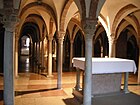
|
Unknown | Nonantola Abbey, Modena | Crypt altar[26] |
10th century[]
| Pontificate | Portrait | Common English name | Image | Sculptor | Location | Notes |
|---|---|---|---|---|---|---|
| October 974 – 10 July 983 | 
|
Benedict VII | 
|
Unknown | Santa Croce in Gerusalemme | Funerary inscription embedded in the wall near the entrance[27] |
| 3 May 996 – 18 February 999 | 
|
Gregory V | 
|
Unknown | St. Peter's Basilica | Tomb discovered on August 14, 1607 under the pavement of St. Peter's; exhumed and reburied on January 15, 1609 in a fourth/fifth century sarcophagus[28] |
| 2 April 999 – 12 May 1003 | 
|
Sylvester II | 
|
and | Archbasilica of Saint John Lateran | Destroyed in the Lateran fire of 1308; charred remains were collected and buried in a polyandrum in the same basilica; epitaph reingraved on a cenotaph in the same basilica; modern monument created in 1910[29] |
11th–15th centuries[]
11th century[]
| Pontificate | Portrait | Common English name | Image | Sculptor | Location | Notes |
|---|---|---|---|---|---|---|
| 31 July 1009 – 12 May 1012 | 
|
Sergius IV | 
|
Francesco Borromini | Archbasilica of Saint John Lateran | Original destroyed in a fire in either 1308 or 1361; remains collected in a polyandrum in the same basilica; new cenotaph placed on the right side of the main nave by Borromini in the seventeenth century[30] |
| 24 December 1046 – 9 October 1047 | 
|
Clement II | 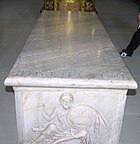
|
"Reims workshop"[31] | Bamberg Cathedral | Only extant papal tomb outside of Italy and France;[32][33][34] original completed circa 1237, dismantled in the seventeenth century, separating the tomb-chest and effigy; tomb-chest constructed with marble from Kärnten[31][35] |
| 17 July 1048 – 9 August 1048 | 
|
Damasus II | 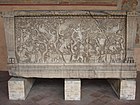
|
Unknown | San Lorenzo fuori le Mura | Sarcophagus in the portico[36][37] |
| 12 February 1049 – 19 April 1054 | 
|
Leo IX Saint Leo |
Unknown | St. Peter's Basilica | Originally buried in the east wall of Old St. Peter's, close to the altar of Gregory I; coffin opened on January 11, 1606 during the demolition of Old St. Peter's and parts were taken as relics; remainder reburied under the altar of Saints Marziale and Valeria,[38] now dedicated to the Crucifixion of St. Peter. | |
| 22 April 1073 – 25 May 1085 | 
|
Gregory VII, O.S.B. Saint Gregory |

|
Unknown | Salerno Cathedral | Originally buried in the Church of St. Matthew; discovered in 1573, opened in 1578, reburied beneath the Salerno altar; opened again in 1605 (head taken to ; corpse translated to chapel of the Crociata); original sarcophagus placed in transept in 1954[39] |
| 24 May 1086 – 16 September 1087 | 
|
Victor III, O.S.B. Blessed Victor |

|
Unknown | Abbey of Monte Cassino | Translated in 1515 to the altar in the chapel of St. Bertharius, then the chapel of St. Victor; transferred from Monte Cassino during World War II to San Polo fuori le Mura, avoiding the aerial bombing that destroyed the original chapel;[40] returned to the rebuilt basilica of Monte Cassino in 1963[41] |
12th century[]
| Pontificate | Portrait | Common English name | Image | Sculptor | Location | Notes |
|---|---|---|---|---|---|---|
| 24 January 1118 – 28 January 1119 | 
|
Gelasius II, O.S.B. | 
|
Unknown | Cluny Abbey | Tuscan-style bright marble tomb destroyed in 1792 during the French Revolution;[42] fragments remain[43] |
| 14 February 1130 – 24 September 1143 | 
|
Innocent II, Can. Reg. | 
|
Vespignani (design) | Santa Maria in Trastevere | Originally buried in the porphyry sarcophagus of Emperor Hadrian in the Archbasilica of Saint John Lateran; damaged during the fire of 1308 and moved to the vestibule; moved to a simple slab in the fifteenth century; moved to Santa Maria Trastevere[44] |
| 8 July 1153 – 3 December 1154 | 
|
Anastasius IV | 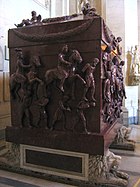
|
Unknown | Vatican Museum | Reused the sarcophagus of Helena of Constantinople, Constantine's mother; only tomb to survive the Lateran fires of 1308 and 1361 (restored fully in 1509); moved to the treasury of the Vatican Museum in the nineteenth century[45] |
| 4 December 1154 – 1 September 1159 | 
|
Adrian IV, O.S.A. | 
|
Unknown | St. Peter's Basilica | Reused an Early Christian sarcophagus[46] |
| 7 September 1159 – 30 August 1181 | 
|
Alexander III | 
|
Francesco Borromini | Archbasilica of Saint John Lateran | Ruined by mob graffiti and then destroyed in the Lateran fire of 1308 or 1361; new cenotaph raised in seventeenth century[47] |
| 1 September 1181 – 25 November 1185 | 
|
Lucius III | Unknown | Verona Cathedral | Originally buried in a marble sarcophagus in front of the high altar; moved beneath the pavement under a red Veronese marble slab during the reign of bishop Gilberti (1524–1543); damaged during a storm on February 25, 1879; recovered with marble thereafter and original slab hung on the wall of the Cathedral[48][49] | |
| 25 November 1185 – 19 October 1187 | 
|
Urban III | 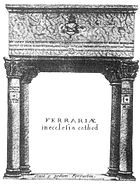
|
G.B. Boffa (modern cenotaph) | Ferrara Cathedral | Moved several times; original tomb replaced with cenotaph in fifteenth century[50] |
| 8 January 1198 – 16 July 1216 | 
|
Innocent III | 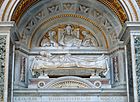
|
Archbasilica of Saint John Lateran | Originally buried in the Perugia Cathedral; moved several times within the Cathedral, and temporarily combined with Urban IV and Martin IV, before being transferred to Archbasilica of Saint John Lateran in 1891[51] |
13th century[]
| Pontificate | Portrait | Common English name | Image | Sculptor | Location | Notes |
|---|---|---|---|---|---|---|
| 25 June 1243 – 7 December 1254 | 
|
Innocent IV | 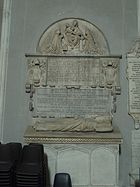
|
Tommaso Malvito | Naples Cathedral | Original, commissioned by archbishop Humbert of Montauro, almost completely destroyed; the recumbent figure (with the anachronistic round top tiara) and above reliefs were added in the sixteenth century[52] |
| 29 August 1261 – 2 October 1264 | 
|
Urban IV | [53] | Giovanni Pisano (original) | Perugia Cathedral | Destroyed in the late fourteenth century, save the epitaph which is currently in the Civic Museum of Perugia; combined with Innocent III and Martin IV in 1587 and interred in the sacristy;[54] Innocent III's remains were transferred to the Archbasilica of Saint John Lateran in the late nineteenth century, but the iron casket is extant in the sacristy of the Perugia Cathedral;[10] possibly translated to the Troyes Cathedral in 1901[55] |
| 5 February 1265 – 29 November 1268 | 
|
Clement IV | 
|
San Francesco (Viterbo) | Translated from Santa Maria in Gradi[56][57] | |
| 1 September 1271 – 10 January 1276 | 
|
Gregory X Blessed Gregory |
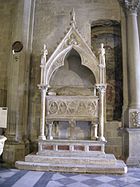
|
Margaritone d'Arezzo | Arezzo Cathedral | Original body and sarcophagus are extant[43][58] |
| 11 July 1276 – 18 August 1276 | 
|
Adrian V | 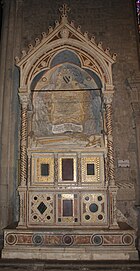
|
Arnolfo di Cambio (possibly Pietro Vassalletto) | San Francesco (Viterbo) | Modified in 1994[57][59] |
| 8 September 1276 – 20 May 1277 | 
|
John XXI | 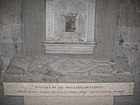
|
Viterbo Cathedral | Original destroyed in the sixteenth century, no longer extant;[57] new monument constructed in the 19th century and damaged during World War II,[60] of which a sarcophagus and other fragments remain[10][61] | |
| 25 November 1277 – 22 August 1280 | 
|
Nicholas III | 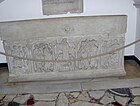
|
Unknown | St. Peter's Basilica | Original destroyed during the demolition of Old St. Peter's; combined with two Rainaldo Orsinis in 1620[62] |
| 22 February 1281 – 28 March 1285 | 
|
Martin IV | [53] | Giovanni Pisano | Perugia Cathedral | Original tomb destroyed by 1375; reconstructed and redestroyed by the end of the fourteenth century; combined with Popes Urban IV and Innocent III in 1587; Innocent III's remains were transferred to the Archbasilica of Saint John Lateran in the late nineteenth century, but the iron casket containing Martin IV and possibly Urban IV is extant in the sacristy of the Perugia Cathedral[10] |
| 2 April 1285 – 3 April 1287 | 
|
Honorius IV | 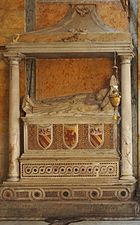
|
Arnolfo di Cambio (disputed)[63] | Santa Maria in Aracoeli | Original destroyed early in the demolition of Old St. Peter's; baldecchio destroyed and replaced in 1727[64][65]
|
| 22 February 1288 – 4 April 1292 | 
|
Nicholas IV, O.F.M. | 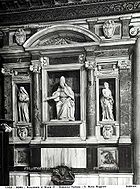
|
Domenico Fontana (design) (sculptor) Leonardo Sormani (figures) |
Basilica di Santa Maria Maggiore | Originally buried in a simple urn; mausoleum commissioned in the late sixteenth century[67] |
| 5 July 1294 – 13 December 1294 | 
|
Celestine V, O.S.B. Saint Celestine |

|
Santa Maria di Collemaggio (L'Aquila) | Originally buried in Church of St. Anthony; moved to Church of St. Agatha; stolen in 1327 by L'Aquilan friars;[68] damaged in the 2009 L'Aquila earthquake[69] | |
| 24 December 1294 – 11 October 1303 | 
|
Boniface VIII | 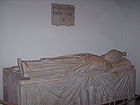
|
Unknown | St. Peter's Basilica | Original tomb chapel, into which Boniface VIII had moved the relics of Boniface IV, destroyed[70][71] |
14th century[]
| Pontificate | Portrait | Common English name | Image | Sculptor | Location | Notes |
|---|---|---|---|---|---|---|
| 22 October 1303 – 7 July 1304 | 
|
Benedict XI, O.P. Blessed Benedict |
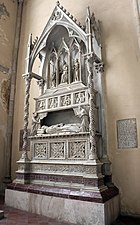
|
Giovanni Pisano | Basilica of San Domenico (Perugia) | Wall tomb and ossuary[43][72] |
| 5 June 1305 – 20 April 1314 | 
|
Clement V | 
|
Collegiate church (Uzeste) | [73] | |
| 7 August 1316 – 4 December 1334 | 
|
John XXII | 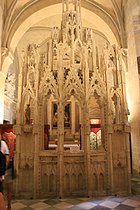
|
Unknown | Avignon Cathedral | Moved several times within the Cathedral's chapels; all 60 statuettes have been stolen, head of effigy is originally from another bishop's tomb; damaged badly during French Revolution[74][75] |
| 20 December 1334 – 25 April 1342 | 
|
Benedict XII, O.Cist. | 
|
Avignon Cathedral | Bust of Benedict XII in the St. Peter's Basilica grottoes;[76] fragments of original in Fondation Calvet[43] | |
| 7 May 1342 – 6 December 1352 | 
|
Clement VI | 
|
, , and | Abbey of La Chaise-Dieu | Sculpted weepers in Musée Crozatier, Le Puy;[77][78] sculpted angel in Musée de Petit-Palais, Avignon[79] |
| 18 December 1352 – 12 September 1362 | 
|
Innocent VI | 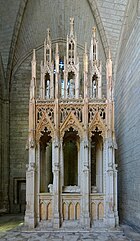
|
Chartreuse du Val de Bénédiction (Villeneuve-lès-Avignon) | [80] | |
| 28 September 1362 – 19 December 1370 | 
|
Urban V, O.S.B. Blessed Urban |
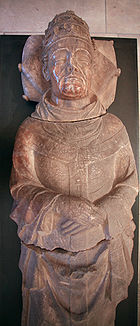
|
Abbey of St. Victor (Marseille) | Effigy in Musée de Petit-Palais, Avignon[81][82] | |
| 30 December 1370 – 26 March 1378 | 
|
Gregory XI | 
|
Santa Francesca Romana | Original Olivieri relief carved in 1584 (drawing above);[83] replica located in Palais des Papes | |
| 8 April 1378 – 15 October 1389 | 
|
Urban VI | 
|
Unknown | St. Peter's Basilica | Saved during the deconstruction of Old St. Peter's; nearly dumped by workmen for use as a water trough[84][85] |
15th century[]
| Pontificate | Portrait | Common English name | Image | Sculptor | Location | Notes |
|---|---|---|---|---|---|---|
| 17 October 1404 – 6 November 1406 | 
|
Innocent VII | 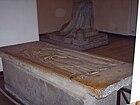
|
Unknown | St. Peter's Basilica | Originally buried in the Chapel of Saints Peter and Paul, moved to the Chapel of St. Thomas in 1455, moved into a mid-fifteenth century copy of the original sarcophagus on September 12, 1606[86] |
| 30 November 1406 – 4 July 1415 | 
|
Gregory XII | 
|
Camillo Rusconi | (Recanati) | Cardinal at the time of his death, due to his resignation during the Council of Constance; Moved in 1623, 1760, and 1793; illustrations of an "original" tomb (pictured) have been deemed fabrications by historians;[87] last papal tomb outside Rome (c.f. Tomb of Antipope John XXIII); original sarcophagus extant[10] |
| 11 November 1417 – 20 February 1431 | 
|
Martin V | 
|
Simone Ghini | Archbasilica of Saint John Lateran[88] | Moved in front of the high altar in 1853[89] |
| 3 March 1431 – 23 February 1447 | 
|
Eugene IV, O.S.A. | 
|
and | San Salvatore in Lauro | Moved out of Old St. Peter's before its demolition[90] |
| 6 March 1447 – 24 March 1455 | 
|
Nicholas V, O.P. | 
|
Mino da Fiesole | St. Peter's Basilica | Moved from the left outer aisle of Old St. Peter's to the right outer aisle; monument (not sarcophagus) destroyed during the demolition of Old St. Peter's[91] |
| 8 April 1455 – 6 August 1458 | 
|
Callixtus III | 
|
Unknown | St. Peter's Basilica | Originally located in Chapel of St. Mary della febbre; monument, but not sarcophagus, destroyed during the demolition of Old St. Peter's[92] |

|
Santa Maria in Monserrato | Remains later combined with Alexander VI[92] | ||||
| 19 August 1458 – 15 August 1464 | 
|
Pius II | Paolo Romano | Sant'Andrea della Valle | Heart enshrined in the Duomo of Ancona; originally buried in the Chapel of St. Andrews in St. Peter's; moved to San Andrea della Valle in 1614[93] | |
| 30 August 1464 – 26 July 1471 | 
|
Paul II | 
|
Giovanni Dalmata (effigy) Mino da Fiesole (figures and bas-reliefs) |
St. Peter's Basilica | Monument moved in 1544 and torn down in seventeenth century; sarcophagus survived demolition of Old St. Peter's[94] |
| 9 August 1471 – 12 August 1484 | 
|
Sixtus IV, O.F.M. | Antonio del Pollaiolo | Treasury Museum of St. Peter's Basilica | Originally located in the choir chapel of Old St. Peter's; moved in 1610 to the sacristy; moved in 1625 to the Chapel del Coro in new St. Peter's; combined with Julius II in 1926; moved again in 1940s[95] | |
| 29 August 1484 – 25 July 1492 | 
|
Innocent VIII | 
|
Antonio del Pollaiolo | St. Peter's Basilica | First papal tomb to depict a live pope rather than a deathbed effigy; originally placed in the Oratory of Our Lady in Old St. Peter's. |
| 11 August 1492 – 18 August 1503 | 
|
Alexander VI | 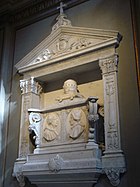
|
Santa Maria di Monserrato | Originally located in the oratory of Saints Cosmas and Damian, in the round chapel of Santa Maria de Febribus; moved in the sixteenth century next to Calixtus III; combined in 1582 in the Chapel of Santa Maria della Febbre; survived demolition of Old St. Peter's but broken up in 1605; urns were taken to Santa Maria di Monserrato; monument in Chapel of St. Diego sculpted in 1881[96] |
16th–21st centuries[]
16th century[]
| Pontificate | Portrait | Common English name | Image | Sculptor | Location | Notes |
|---|---|---|---|---|---|---|
| 22 September 1503 – 18 October 1503 | 
|
Pius III | 
|
Unknown | St. Peter's Basilica | Originally built in Old St. Peter's; last papal mausoleum erected in Old St. Peter's[97] |
| Sant'Andrea della Valle | Moved to Sant'Andrea della Valle by Paul V[97] | |||||
| 31 October 1503 – 21 February 1513 | 
|
Julius II | 
|
Michelangelo Possible assistants include: Antonello Gagini Giacomo del Duca |
San Pietro in Vincoli | Original, planned tomb—intended for the Cappella Maggiore of St. Peter's—never completed and moved to San Pietro in Vincoli[98] See Tomb of Pope Julius II, Moses and Dying Slave |
| Unknown | St. Peter's Basilica | Actual remains deposited in a simple sarcophagus, combined with Sixtus IV, his uncle[97] | ||||
| 9 March 1513 – 1 December 1521 | 
|
Leo X | 
|
Baccio Bandinelli (design) Antonio da Sangallo the Younger (monument) Raffaello da Montelupo (statue) |
Santa Maria sopra Minerva | Translated from Old St. Peter's in 1536[99] |
| 9 January 1522 – 14 September 1523 | 
|
Adrian VI | 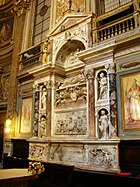
|
Baldassare Peruzzi (design) and Niccolò Tribolo (carved) |
Santa Maria dell'Anima | Translated from Old St. Peter's in 1533 to the national church of the Holy Roman Empire[100] |
| 26 November 1523 – 25 September 1534 | 
|
Clement VII | 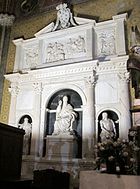
|
Nanni di Baccio Bigio | Santa Maria sopra Minerva | Originally buried in a brick tomb in Old St. Peter's; tomb is across from that of Leo X, another Medici pope[101] |
| 13 October 1534 – 10 November 1549 | 
|
Paul III | 
|
Guglielmo della Porta | St. Peter's Basilica | Moved in 1599[102] |
| 7 February 1550 – 29 March 1555 | 
|
Julius III | 
|
Unknown | St. Peter's Basilica | Originally buried in St. Peter's Basilica sans monument in a red stone sarcophagus in the chapel of San Andrea; reinterred in an ancient sarcophagus in 1608, which was reopened two years later during the demolition of Old St. Peter's;[103] sometimes cited as buried in the Del Monte chapel of San Pietro in Montorio along with his adopted cardinal-nephew, Innocenzo Ciocchi Del Monte[104] |
| 9 April 1555 – 30 April or 1 May 1555 | 
|
Marcellus II | 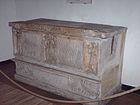
|
Unknown | St. Peter's Basilica | No monument; fourth century sarcophagus, bearing a traditio legis[105] |
| 23 May 1555 – 18 August 1559 | 
|
Paul IV | Pirro Ligorio (design) , , , and (sculpted) |
Santa Maria sopra Minerva | [106] | |
| 26 December 1559 – 9 December 1565 | 
|
Pius IV | 
|
Unknown | Santa Maria degli Angeli e dei Martiri | Moved from Old St. Peter's in 1583; buried under the altar with a nearby wall plaque[107] |
| 7 January 1566 – 1 May 1572 | 
|
Pius V, O.P. Saint Pius |

|
Domenico Fontana (design) Leonardo Sormani (effigy) Nicholas Cordier (left and right bas-reliefs) (center bas-relief) Pierre Le Gros the Younger (design and execution of the sarcophagus) |
Basilica di Santa Maria Maggiore | Translated from Old St. Peter's in 1583[108] After the canonisation process was started by Antonin Cloche, the sarcophagus with the body of the saint was added in 1697–98. A flap of gilded bronze, showing the effigy of the pope in shallow relief, is hinged and can be opened to venerate the body of the saint.[109] |
| 13 May 1572 – 10 April 1585 | 
|
Gregory XIII | 
|
Camillo Rusconi | St. Peter's Basilica | Original monument destroyed; new monument built in eighteenth century[110] |
| 24 April 1585 – 27 August 1590 | 
|
Sixtus V, O.F.M. Conv. | 
|
Domenico Fontana (design) (sculpted) |
Basilica di Santa Maria Maggiore | [111] |
| 15 September 1590 – 27 September 1590 | 
|
Urban VII | 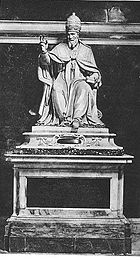
|
Ambrogio Buonvicino | Santa Maria sopra Minerva | [112] |
| 5 December 1590 – 15 /16 October 1591 | 
|
Gregory XIV | St. Peter's Basilica | [113] | ||
| 29 October 1591 – 30 December 1591 | 
|
Innocent IX | 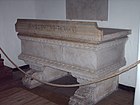
|
Unknown | St. Peter's Basilica | No monument[113] |
| 30 January 1592 – 3 March 1605 | 
|
Clement VIII | 
|
Flaminio Ponzio (design) | Basilica di Santa Maria Maggiore | Moved in 1646 to the Borghese Crypt in the Paulline Chapel in Santa Maria Maggiore; figure of Clement VIII was carved by and the cornice figures by Pietro Bernini; features "The Peace of Henry IV and Philip III by Ippolito Buzzi and "The Coronation of Clement VIII" by Bernini, "The Canonization of St. Giacinto and St. Raimondo" by , "The Occupation of Ferrara" by , and "Invitation of the Troops in Hungary" by Camillo Mariani[114] |
17th century[]
| Pontificate | Portrait | Common English name | Image | Sculptor | Location | Notes |
|---|---|---|---|---|---|---|
| 1 April 1605 – 27 April 1605 | 
|
Leo XI | 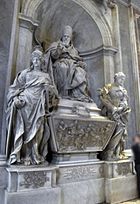
|
Alessandro Algardi (pope and sarcophagus) Ercole Ferrata (Prudence) Giuseppe Peroni (Liberty) |
St. Peter's Basilica | [115] |
| 16 May 1605 – 28 January 1621 | 
|
Paul V | 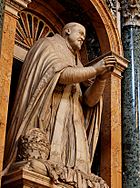
|
Flaminio Ponzio (design) (figure of pope) , , Ippolito Buzzi, , and (reliefs) (cornice figures) |
Basilica di Santa Maria Maggiore | Moved from the Borghese Chapel of St. Peter's to the Pauline chapel of Santa Maria Maggiore[115] |
| 9 February 1621 – 8 July 1623 | 
|
Gregory XV | 
|
Pierre Le Gros the Younger (design and execution) Pierre-Étienne Monnot (sculpted the two Famae from designs by Le Gros)) |
Sant'Ignazio | Uniquely combines the pope's tomb with that of his cardinal-nephew, Ludovico Ludovisi. According to Reardon[116] the pope was originally buried in the Quirinal Palace and his remains moved to Sant'Ignazio in 1634. The monument was created c. 1709–14.[117] |
| 6 August 1623 – 29 July 1644 | 
|
Urban VIII | 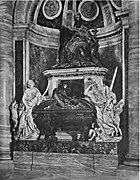
|
Gian Lorenzo Bernini | St. Peter's Basilica | [118] |
| 15 September 1644 – 7 January 1655 | 
|
Innocent X | 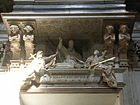
|
G. Valvassori and G.B. Maini | Sant'Agnese in Agone | Cenotaph featuring the Virtues (left) and Strength (right) erected in 1730[119] |
| 7 April 1655 – 22 May 1667 | 
|
Alexander VII | 
|
Gian Lorenzo Bernini (monument) (figure of pope) Giuseppe Mazzuoli (Charity) Lazzaro Morelli and (Truth) and (Prudence) (Justice) |
St. Peter's Basilica | Sculpted between 1672 and 1678; Charity's breast's covered by Innocent XI[120] See Tomb of Pope Alexander VII |
| 20 June 1667 – 9 December 1669 | 
|
Clement IX | 
|
Ercole Ferrata | Basilica di Santa Maria Maggiore | Moved from St. Peter's in 1675; figures are Clement IX (by Girolamo Rainaldi), Charity (by Ferrata), and Truth (by Cosimo Fancelli)[121] |
| 29 April 1670 – 22 July 1676 | 
|
Clement X | 
|
Mattia de' Rossi (design) | St. Peter's Basilica | Figures are Clement X (by Ercole Ferrata), Clemency (by Giuseppe Mazzuoli), Goodness (by Lazzaro Morelli), and two putti (by )[122] |
| 21 September 1676 – 11/12 August 1689 | 
|
Innocent XI Blessed Innocent XI |

|
C. Maratta (design) Pierre Etienne Monnot (sculpted) |
St. Peter's Basilica | Featured the pope with the Virtue Truth and the Goddess Athena; bas-relief on the sarcophagus reads "The Liberation of Vienna"[123] |
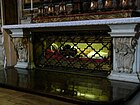
|
Unknown | Separate glass sarcophagus moved under the altar of the Transfiguration after his body was removed from the altar of Saint Sebastian in 2011[123] | ||||
| 6 October 1689 – 1 February 1691 | 
|
Alexander VIII | 
|
Angelo de Rossi | St. Peter's Basilica | [124] |
| 12 July 1691 – 27 September 1700 | 
|
Innocent XII | 
|
Filippo della Valle and Ferdinando Fuga | St. Peter's Basilica | Moved from the tribune to the left transept in the late eighteenth century by Cardinal Giuseppe Spinelli; originally buried in a simple marble sarcophagus in the Chapel of the Sacrament; present monument completed in 1746; features the pope bestowing the benediction with Charity (left) and Justice (right)[125] |
18th century[]
| Pontificate | Portrait | Common English name | Image | Sculptor | Location | Notes |
|---|---|---|---|---|---|---|
| 23 November 1700 – 19 March 1721 | 
|
Clement XI | 
|
Carlo Fontana | St. Peter's Basilica | In the Choir chapel; no monument;[126] cenotaph also placed in Ferrara Cathedral[43] |
| 8 May 1721 – 7 March 1724 | 
|
Innocent XIII | 
|
Unknown | St. Peter's Basilica | Originally buried in a stucco sepulcher in the right nave of St. Peter's; reinterred in an ancient sarcophagus in 1836[127] |
| 29 May 1724 – 21 February 1730 | 
|
Servant of God Benedict XIII, O.P. |
Pietro Bracci and Carlo Marchionni | Santa Maria sopra Minerva | Remains were originally with his monument in St. Peter's Basilica[127] | |
| 12 July 1730 – 6 February 1740 | 
|
Clement XII | 
|
Giovanni Battista Maini | Archbasilica of Saint John Lateran | [128] |
| 17 August 1740 – 3 May 1758 | 
|
Benedict XIV | 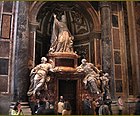
|
Pietro Bracci | St. Peter's Basilica | Two figures are Knowledge (by Bracci) and Temptation (by )[129] |
| 6 July 1758 – 2 February 1769 | 
|
Clement XIII | 
|
Antonio Canova | St. Peter's Basilica | [129] |
| 19 May 1769 – 22 September 1774 | 
|
Clement XIV, O.F.M. Conv. | 
|
Antonio Canova | Santi Apostoli, Rome | Moved to Santi Apostoli in 1802[130] |
| 15 February 1775 – 29 August 1799 | 
|
Pius VI | 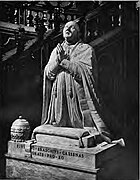
|
Antonio Canova | Crypt of St. Peter's Basilica | Monument by Antonio Canova, circa 1822[43] |
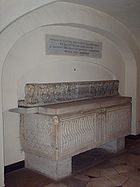
|
Unknown | Remains placed in an ancient sarcophagus with a bas-relief of the Adoration of the Magi by Pius XII in 1949 (below); original praecordia monument in the Valence Cathedral sculpted by and commissioned by Napoleon[43] | ||||
| 14 March 1800 – 20 August 1823 | 
|
Servant of God Pius VII, O.S.B. |

|
Bertel Thorvaldsen | St. Peter's Basilica | Commissioned at the expense of Cardinal Consalvi, Pius VII's Secretary of State, it depicts the pope blessing the angels of Time and History, with the onlooking figures of Fortitude (left) and Wisdom (right)[131] |
19th century[]
| Pontificate | Portrait | Common English name | Image | Sculptor | Location | Notes |
|---|---|---|---|---|---|---|
| 28 September 1823 – 10 February 1829 |

|
Leo XII | 
|
St. Peter's Basilica | [132] | |
| 31 March 1829 – 1 December 1830 |

|
Pius VIII | 
|
Pietro Tenerani | St. Peter's Basilica | Moved from the Vatican grottoes in 1857 to the Tenerani monument commissioned by Cardinal Albani; figures are the kneeling pontiff and seated Christ as well as Saints Peter (left) and Paul (right); base reliefs are Prudence (left) and Justice (right)[132] |
| 2 February 1831 – 1 June 1846 |

|
Gregory XVI O.S.B. Cam. |

|
St. Peter's Basilica | [133] | |
| 16 June 1846 – 7 February 1878 |

|
Blessed Pius IX |

|
Unknown | San Lorenzo fuori le Mura | [134] |
| 20 February 1878 – 20 July 1903 |

|
Leo XIII | 
|
Giulio Tadolini | Archbasilica of Saint John Lateran | Tomb monument[10] |
20th–21st centuries[]
| Pontificate | Portrait | Common English name | Image | Sculptor | Location | Notes |
|---|---|---|---|---|---|---|
| 4 August 1903 – 20 August 1914 |

|
Saint Pius X |
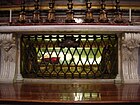
|
Florestano Di Fausto (architect) |
St. Peter's Basilica | [135] |
| 3 September 1914 – 22 January 1922 |

|
Benedict XV | 
|
Pietro Canonica | St. Peter's Basilica | Monument in St. Peter's[136] |

|
(bronze effigy) | Tomb[136] | ||||
| 6 February 1922 – 10 February 1939 |

|
Pius XI | 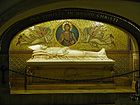
|
Giannino Castiglioni | Chapel of Saint Sebastian[137] | Candoglia marble sarcophagus topped with a deathbed effigy[138] |
| 2 March 1939 – 9 October 1958 |

|
Venerable Pius XII |

|
Francesco Messina (bronze funeral monument) | St. Peter's Basilica | Funeral monument in St. Peter's separate from sarcophagus in the Vatican grottoes.[139] |
| 28 October 1958 – 3 June 1963 |

|
Saint John XXIII |
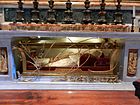
|
Emilio Greco | St. Peter's Basilica | Moved from the Vatican grottoes to the Altar of Saint Jerome after his beatification on 3 September 2000.[140] |
| 21 June 1963 – 6 August 1978 |

|
Saint Paul VI |
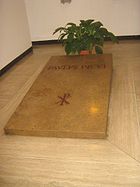
|
Unknown | St. Peter's Basilica | Three reliefs are from the fifteenth century; "as simple as possible [...] neither tomb nor monument" and buried in the ground per Paul VI's wishes.[141] |
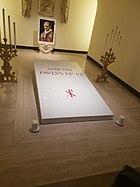
|
Unknown | Updated in October 2018 with "Sanctvs" for his canonisation. | ||||
| 26 August 1978 – 28 September 1978 |

|
Venerable John Paul I |

|
(design) Andrea Bregno (reliefs) |
St. Peter's Basilica | Reliefs are late fifteenth century; across the aisle from Marcellus II, another short-reigning pope.[142] |
| 16 October 1978 – 2 April 2005 |

|
Saint John Paul II |
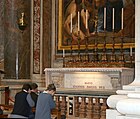
|
Unknown | St. Peter's Basilica | See Funeral of Pope John Paul II.
His body was moved from the Vatican grottoes to the chapel of Saint Sebastian after his beatification on 1 May 2011. The inscription "Beatvs" was changed in April 2014 to "Sanctvs" for his canonization. |
See also[]
- Index of Vatican City-related articles
Notes[]
- ^ Mann, 2003, p. 1.
- ^ Reardon, 2004, pp. 5–12.
- ^ Reardon, 2004, pp. 269–271.
- ^ Reardon, 2004, pp. 23–26.
- ^ Reardon, 2004, p. 23.
- ^ Reardon, 2004, pp. 10–11.
- ^ Reardon, 2004, pp. 272–277.
- ^ Reardon, 2004, pp. 70–109.
- ^ Reardon, 2004, p. 25.
- ^ Jump up to: a b c d e f g Reardon, 2004, p. 270.
- ^ Reardon, 2004, p. 30.
- ^ Reardon, 2004, p. 31.
- ^ Reardon, 2004, pp. 34–35.
- ^ Reardon, 2004, p. 40–41.
- ^ Reardon, 2004, pp. 46–48.
- ^ Reardon, 2004, p. 48.
- ^ Jump up to: a b Mann, 2003, p. 22.
- ^ Reardon, 2004, pp. 49–51.
- ^ Reardon, 2004, pp. 54–55.
- ^ Reardon, 2004, p. 60.
- ^ Gardner, 1992, ill. 16.
- ^ Mann, 2003, p. 24.
- ^ Reardon, 2004, p. 61.
- ^ Reardon, 2004, p. 62.
- ^ Jump up to: a b Reardon, 2004, p. 64.
- ^ Reardon, 2004, pp. 66.
- ^ Reardon, 2004, p. 74.
- ^ Reardon, 2004, p. 76.
- ^ Reardon, 2004, p. 77.
- ^ Reardon, 2004, p. 80.
- ^ Jump up to: a b Williamson, Paul. (1998). Gothic sculpture, 1140–1300. pp. 95–98.
- ^ Beckwith, John. (1961). "Review: The Tomb of Pope Clement II at Bamberg". The Burlington Magazine, Vol. 103, No. 700, pp. 321–322.
- ^ Turner, Jane. (1996). The dictionary of art. p. 139.
- ^ Porter, Darwin. (2004). Frommer's Germany. p. 210.
- ^ Reardon, 2004, pp. 82–83.
- ^ Gardner, 1992, ill. 9.
- ^ Reardon, 2004, p. 83.
- ^ Reardon, 2004, p. 84.
- ^ Reardon, 2004, p. 87.
- ^ Reardon, 2004, p. 88.
- ^ Thomas, Sarah Fawcett. (2000). Butler's Lives of the Saints: September / revised by Sarah Fawcett Thomas. Continuum International Publishing. ISBN 978-0-86012-258-6. p. 150.
- ^ Reardon, 2004, p. 89.
- ^ Jump up to: a b c d e f g Reardon, 2004, p. 269.
- ^ Reardon, 2004, pp. 90–91.
- ^ Reardon, 2004, p. 93.
- ^ Gardner, 1992, ill. 11.
- ^ Reardon, 2004, p. 95.
- ^ Mann, 2003, p. 32.
- ^ Gardner, 1992, ill. 12.
- ^ Reardon, 2004, p. 98.
- ^ Reardon, 2004, p. 100.
- ^ Reardon, 2004, pp. 102–103.
- ^ Jump up to: a b An illustration of the iron casket can be seen in Reardon, 2004, p. 113.
- ^ Reardon, 2004, p. 104.
- ^ Keys to Umbria: City Walks. May 22, 2009 (retrieved). "Interior of the Duomo Archived 2009-01-07 at the Wayback Machine ".
- ^ Gardner, 1992, p. 36, ill. 21, 25–27, 31.
- ^ Jump up to: a b c Frothingham, A. L., Jr. (1891). "Notes on Roman Artists of the Middle Ages. III. Two Tombs of the Popes at Viterbo by Vassallectus and Petrus Oderisi". The American Journal of Archaeology and of the History of the Fine Arts, 7(1/2): 38.
- ^ Gardner, 1992, ill. 132–135.
- ^ Gardner, 1992, ill. 34–38.
- ^ Reardon, 2004, p. 109.
- ^ An illustration of the nineteenth century Tomb of Pope John XXI can be found in: Daly, Walter J. (2004). "An Earlier De Motu Cordis". Transactions of the American Clinical and Climatological Association, Vol. 115.
- ^ Reardon, 2004, p. 111.
- ^ Jump up to: a b P. Cellini, Di Fra' Guglielmo e di Arnolfo, BArte, s. IV, 40, 1955, pp. 215-229
- ^ Gardner, 1992, ill. 97–99.
- ^ Reardon, 2004, p. 115.
- ^ P. Cellini, Di Fra' Guglielmo e di Arnolfo, BArte, s. IV, 40, 1955, pp. 215-229
- ^ Reardon, 2004, p. 116.
- ^ Reardon, 2004, p. 118.
- ^ Kington, Tom (14 April 2009). "Italy earthquake focus shifts to saving Abruzzo's heritage". The Guardian.
- ^ Gardner, 1992, ill. 106–108, 111–112.
- ^ Reardon, 2004, pp. 120–121.
- ^ Gardner, 1992, ill. 88, 124–130.
- ^ Gardner, 1992, ill. 176–179.
- ^ Gardner, 1992, ill. 167–172.
- ^ Reardon, 2004, p. 126.
- ^ Gardner, 1992, ill. 139.
- ^ Gardner, 1992, ill. 183–184.
- ^ Gardner, 1992, ill. 186.
- ^ Gardner, 1992, ill. 195–196.
- ^ Gardner, 1992, ill. 190–194.
- ^ Gardner, 1992, ill. 203. As seen in Acta Sanctorum.
- ^ Gardner, 1992, ill. 204–207.
- ^ Reardon, 2004, p. 133.
- ^ Gardner, 1992, ill. 147.
- ^ Reardon, 2004, p. 137.
- ^ Reardon, 2004, pp. 141–142.
- ^ Reardon, 2004, p. 145.
- ^ Gardner, 1992, ill. 18.
- ^ Reardon, 2004, p. 149.
- ^ Reardon, 2004, p. 152.
- ^ Reardon, 2004, p. 153.
- ^ Jump up to: a b Reardon, 2004, p. 156.
- ^ Reardon, 2004, p. 161.
- ^ Reardon, 2004, p. 163.
- ^ Reardon, 2004, p. 167.
- ^ Reardon, 2004, p. 173.
- ^ Jump up to: a b c Reardon, 2004, p. 177.
- ^ Reardon, 2004, pp. 177–178.
- ^ Reardon, 2004, p. 179.
- ^ Reardon, 2004, p. 182.
- ^ Reardon, 2004, 182.
- ^ Reardon, 2004, 185–186.
- ^ Reardon, 2004, p. 186.
- ^ Aldrich, Robert, and Wotherspoon, Garry. (2002). Who's who in gay and lesbian history. Routledge. p. 278.
- ^ Reardon, 2004, p. 187–188.
- ^ Reardon, 2004, p. 188.
- ^ Reardon, 2004, p. 189.
- ^ Reardon, 2004, p. 191.
- ^ Gerhard Bissell, Pierre le Gros, 1666–1719, Reading, Berkshire 1997, pp. 42–44.
- ^ Reardon, 2004, p. 195.
- ^ Reardon, 2004, p. 195–197.
- ^ Reardon, 2004, p. 198.
- ^ Jump up to: a b Reardon, 2004, p. 199.
- ^ Reardon, 2004, p. 201.
- ^ Jump up to: a b Reardon, 2004, p. 204.
- ^ Reardon, 2004, p. 206–207.
- ^ Gerhard Bissell, Pierre le Gros, 1666–1719, Reading, Berkshire 1997, pp. 104–105. Reardon's statement (Reardon, 2004, p. 206–207) that the design was by Orazio Grassi is based on an unreliable source of more than a century ago and not correct; also, while it is correct, as she states, that Camillo Rusconi created statues of the Cardinal Virtues for the chapel, they were there decades before the monument and have nothing to do with it.
- ^ Reardon, 2004, p. 207.
- ^ Reardon, 2004, p. 208–209.
- ^ Reardon, 2004, p. 211.
- ^ Reardon, 2004, pp. 211–213.
- ^ Reardon, 2004, p. 213.
- ^ Jump up to: a b Reardon, 2004, p. 215.
- ^ Olszewski, Edward J. (2004). Cardinal Pietro Ottoboni (1667–1740) and the Vatican tomb of Pope Alexander VIII. Diane Publishing. ISBN 978-0-87169-252-8.
- ^ Reardon, 2004, p. 218.
- ^ Reardon, 2004, p. 218–219.
- ^ Jump up to: a b Reardon, 2004, p. 219.
- ^ Reardon, 2004, p. 221.
- ^ Jump up to: a b Reardon, 2004, p. 223.
- ^ Reardon, 2004, p. 224–225.
- ^ Reardon, 2004, p. 227.
- ^ Jump up to: a b Reardon, 2004, p. 229.
- ^ Reardon, 2004, pp. 229–232.
- ^ Reardon, 2004, pp. 232–233.
- ^ Reardon, 2004, p. 235.
- ^ Jump up to: a b Reardon, 2004, p. 239.
- ^ "The Tomb of Pius XI".
- ^ Reardon, 2004, p. 240.
- ^ Reardon, 2004, p. 243.
- ^ Fodors. 2009, May 24 (accessed). "Basilica di San Pietro Archived 2009-05-08 at the Wayback Machine."
- ^ Reardon, 2004, p. 246.
- ^ Reardon, 2004, p. 249.
References[]
- Gardner, Julian (1992), The Tomb and the Tiara, Oxford: Clarendon Press, ISBN 978-0-19-817510-0
- Mann, H. K. (2003), Tombs and Portraits of the Popes of the Middle Ages, Kessinger Publishing, ISBN 978-0-7661-2903-0
- Reardon, Wendy J. (2004), The Deaths of the Popes, Jefferson: McFarland & Company, Inc., Publishers, ISBN 978-0-7864-1527-4
- Webb, Matilda (2001), The Churches and Catacombs of Early Christian Rome: a comprehensive guide, Brighton: Sussex Academic Press, ISBN 978-1-902210-57-5
External links[]
- (in German) Information and images on papal tombs (1417 and 1799) from the Requiem project
- Papal tombs
- Lists of tombs
- Burial places of popes
- Sarcophagi
- Pope-related lists
- Lists of burials by location
